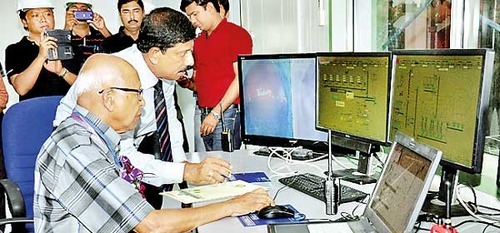San Antonio had to claw its way into contention for Tesla Motors‘ planned “gigafactory,” a dream project that would put 6,500 people to work in a $5 billion plant that produces lithium-ion batteries.
By several accounts, local officials overcame the city’s also-ran status in the early stages of Tesla’s site selection. They finally coaxed the electric-car maker into taking a serious look at San Antonio for the project, which the Palo Alto, Calif.-based company announced in late February.
Now, San Antonio may be considered the strongest potential site in Texas.
That’s because CPS Energy brings a lot to the table as a would-be partner for Tesla and because Mayor Julián Castro is reportedly working as many angles to win the project as he and his staff can think of.
As Tesla vets potential locations, CPS Energy is posting flirtatious Tweets on the virtues of electric vehicles. The city-owned utility is also using social media to play up its commitments to renewable energy — it’s looking to make wind and solar power account for 20 percent of its electricity sources by 2020 — and demand response, which is when customers voluntarily reduce their use of electricity at times of peak demand.
Presumably, that’s music to the ears of Elon Musk, the co-founder, CEO and chairman of Tesla. He’s also co-founder of SolarCity, one of the largest providers of residential solar systems in the U.S., and Tesla’s gigafactory would produce battery packs not just for Tesla vehicles but also “stationary storage applications” for homes and businesses. Solar panels on rooftops and battery systems to store the power they generate would come in handy for the demand response CPS Energy boasts about.
Texas — which is competing against Arizona, Nevada and New Mexico for the gigafactory — also has caught a couple of lucky breaks lately.
A big black mark against both Texas and Arizona is that they basically outlaw Tesla’s distribution model — to sell cars directly to consumers, without going through franchised auto dealers.
True, Texas lawmakers are unlikely to break free of the hold dealers have on them (and their campaign accounts) anytime soon. But at least Arizona proved itself to be in the same position last week; a bill that would have allowed Tesla to sell straight to consumers — perhaps giving the state an edge — died in the legislature, according to news reports.
Also last week, the drive in New Mexico for a special legislative session to OK incentives for the gigafactory appears to have petered out, Albuquerque Business First reported Tuesday.
But as San Antonio officials have gotten their hopes up, questions about the viability of Musk’s gigafactory have been relentless. An April 1 headline in the Wall Street Journal: “Does Tesla Really Need a $5 Billion Battery Factory?”
Some of the skepticism started with Panasonic, which currently supplies lithium-ion batteries to Tesla.
The maker of the luxury Model S sedan is willing to spend $2 billion on the facility, which would take up 10 million square feet and sit on as many as 1,000 acres. The company needs partners to cover the other $3 billion, and Musk suggested Panasonic might be one of them.
But Panasonic’s president, Kazuhiro Tsuga, was noncommittal when he talked with reporters in Tokyo on March 26. As Bloomberg reported, he said: “Elon plans to produce more affordable models besides Model S, and I understand his thinking and would like to cooperate as much as we can. But the investment risk is definitely higher.”
Tesla has stayed mum on potential partners since then.
The big idea behind the gigafactory is that mass production, with raw materials such as lithium and cobalt coming in the front door and battery packs going out the back, will push down the cost of batteries by about 30 percent. Since batteries are the most expensive components of electric vehicles, the cost cuts would make Tesla cars less expensive.
A good thing, considering the Model S now starts at a little more than $70,000.
The company also has its mid-market Model E in the works — a car priced for the rest of us. It’s expected to launch in 2017, the same year Tesla wants its gigafactory to start production.
Some of the questions coming at Tesla are whether it could actually slice 30 percent off of battery production costs, and how it would source the raw materials. But the most important question is whether enough drivers will embrace all-electric vehicles to keep the gigafactory humming.
As planned, the facility would produce enough batteries for 500,000 vehicles per year by 2020.
Selling that many Teslas would be a real feat.
The company began delivering the Model S is 2012 and had sold over 25,000 in North America and Europe by the end of 2013, according to a filing with the Securities and Exchange Commission. For a little perspective: Chevrolet sold 42,000 Silverado trucks in March.
Overseas sales will be critical to Tesla. The manufacturer will start selling Model S sedans in China this month, and in Japan, the United Kingdom and Australia later this year.
A local official I talked with recently, who’s worked on the gigafactory bid, was hopeful but also wary, saying, “There are questions about how viable this project is.
“It depends on your view of the future. Will enough people give up their gas-powered cars?”







